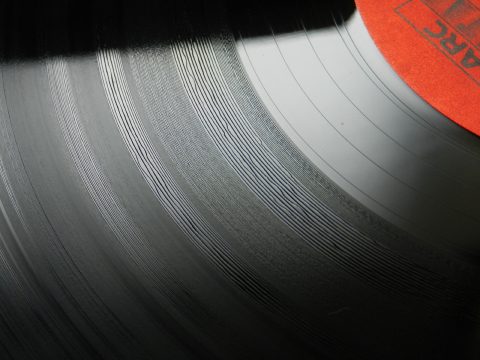5.1 Surround Sound Music & Video – Continental Drift on 3BBR & CRN – Australian Television – Paintings – Design – Cartoons – Animation – Sculpture – Woodcraft

Garry Havrillay presents a quirky 4-part audio series about the humble vinyl LP, with geeky insights into artifacts of the medium;
• using the run-in and run-out grooves as creative space
• multiple spirals on the same side of a disc
• the impact on LP quality during the oil crises of the 1970s
• half-speed cutting for audiophiles, and
• the most challenging record ever made for any stylus & cartridge to navigate!
 Part 1 explores the idea of using the run-out groove as creative space, and the crazy idea of having an "alternate program" by cutting multiple spirals on the same side of a record. (This part is a reworking of an original commission for ABC Radio National.)
Part 1 explores the idea of using the run-out groove as creative space, and the crazy idea of having an "alternate program" by cutting multiple spirals on the same side of a record. (This part is a reworking of an original commission for ABC Radio National.)
PINK FLOYD — Atom Heart Mother (1970) — Dripping tap in the inner lock groove loop // THE BEATLES — Sgt Peppers Lonely Hearts Club Band (1967) — Dog whistle and cut-up collage in the inner loop // NOT DROWNING WAVING — The Little Desert (1985) — Looped wind effect // THE JAMES GANG — Yer Album — Lock-groove message // MONTY PYTHON — Matching Tie and Handkerchief (1973) — Two spirals on Side 2 // RUSH — Rush 'n' Roulette EP (1981) — 6 spirals on each side, each with a different song // THE FONTANE SISTERS — The Fortune Teller Song (1951) — 4 concentric spirals had the same song with different endings // MONTY PYTHON — Another Monty Python Record (1971) — False 'stuck record' effect to alarm the listener
 In Part 2, Garry spins a disc with audio cut into the run-in as well as the run-out groove, explores the care needed to craft a perfect 1.8 second loop in the lock-groove, and the change in pitch when the tonearm swings from side-to-side (known as 'wow').
In Part 2, Garry spins a disc with audio cut into the run-in as well as the run-out groove, explores the care needed to craft a perfect 1.8 second loop in the lock-groove, and the change in pitch when the tonearm swings from side-to-side (known as 'wow').
DEAD KENNEDYS — Plastic Surgery Disasters (1982) — Audio recorded in the Side 1 run-in groove, which continues after the end of side 2 into the lock groove // PETER GABRIEL — Peter Gabriel 2 (1978) — Synth loop to end Side 1 // MIDNIGHT OIL — 10,9,8,7,6,5,4,3,2,1 (1982) — Perfectly looped vocal sustain in the lock groove // THE BEATLES — Sgt Peppers Lonely Hearts Club Band (1967) — Demonstration of extreme wow // CHRONICLE — Like A Message From the Stars (1977) Decelerating koto leading into a less-than-perfect loop
 In Part 3, Garry explains why the audio must be severely equalized to reduce the bass and boost the treble before it's sent to the cutting lathe, and tries to play an audiophile record that recorded real cannons in a pre-CD era precision digital recording (pictured top).
In Part 3, Garry explains why the audio must be severely equalized to reduce the bass and boost the treble before it's sent to the cutting lathe, and tries to play an audiophile record that recorded real cannons in a pre-CD era precision digital recording (pictured top).
THE WHO — The Who Sell Out (1967) — Scratchy gramophone looped at the end of side 2 // BRIAN ENO — Here Come The Warm Jets (1973) — typical of its era, lacking any floor thumping bass // THE BEATLES — Rain (B-side to Paperback Writer single, 1966) — unusually loud bass for its time // CINCINNATI SYMPHONY ORCHESTRA / KUNZEL — Tchiakovsky: 1812 Overture — Arguably one of the most technically demanding LP records ever made
![A Neumann VMS-70 cutting lathe [commons.wikimedia.org] A Neumann VMS-70 cutting lathe [commons.wikimedia.org]](/sites/default/files/VinylOdd_Ep4_150x100.jpg) In Part 4, Garry demonstrates the huge sonic benefits of cutting the record at half-speed, the consequences of recycling surplus LP records (!), and joins the ego trip with artists who looped applause at the end of their concert albums.
In Part 4, Garry demonstrates the huge sonic benefits of cutting the record at half-speed, the consequences of recycling surplus LP records (!), and joins the ego trip with artists who looped applause at the end of their concert albums.
MIKE OLDFIELD — Tubular Bells (1973) — Comparing the original vinyl release, with a half-speed mastered version, albeit a different mix // CONCERTGEBOUW ORCHESTRA / HAITINK / ARRAU — Beethoven: Piano Concerto No. 3 — Recycled vinyl with paper protruding from the surface // ABBA — Super Trouper — Applause looped into the end lock groove // EAGLES — Eagles Live — Applause looped into the end lock groove // CAPTAIN AND TENNILLE — Muskrat Love (1976 single) — Rhythmic tapping accelerates into a gallop which is looped in the lock groove // GEORGE HARRISON — Wonderwall Music — Another album with audio in the lead-in groove. // Recap of lock grooves from previous episodes




